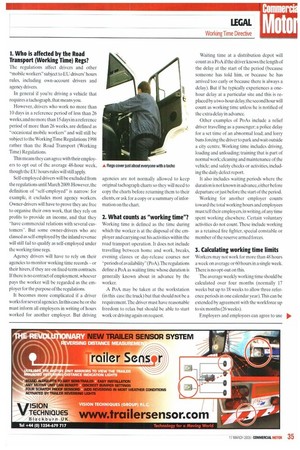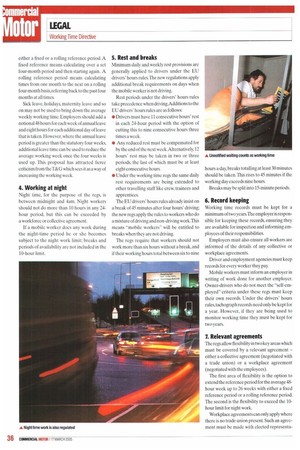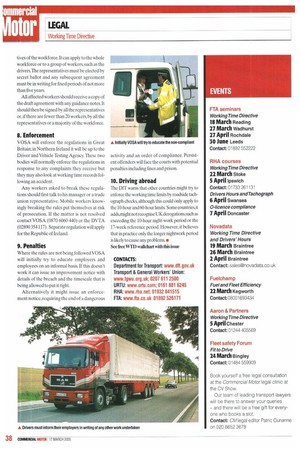1. Who is affected by the Road Transport (Working Time) Regs?
Page 37

Page 38

Page 40

If you've noticed an error in this article please click here to report it so we can fix it.
The regulations affect drivers and other -mobile workers" subject to EU drivers' hours rules, including own-account drivers and agency drivers.
In general if you're driving a vehicle that requires a tachograph, that means you.
However, drivers who work no more than 10 days in a reference period of less than 26 weeks, and no more than 15 days in a reference period of more than 26 weeks, are defined as "occasional mobile workers" and will still be subject to the Working Time Regulations 1998 rather than the Road Transport (Working Time) Regulations.
This means they can agree with their employers to opt out of the average 48-hour week, though the EU hours rules will still apply.
Self-employed drivers will be excluded from the regulations until March 2009. However, the definition of "self-employed" is narrow: for example, it excludes most agency workers. Owner-drivers will have to prove they are free to organise their own work, that they rely on profits to provide an income, and that they "have commercial relations with several customers". But some owner-drivers who are classed as self-employed by the inland revenue will still fail to qualify as self-employed under the working time regs.
Agency drivers will have to rely on their agencies to monitor working time records — or their hirers, if they are on fixed-term contracts. If there is no contract of employment, whoever pays the worker will be regarded as the employer for the purpose of the regulations.
It becomes more complicated if a driver works for several agencies. In this case he or she must inform all employers in writing of hours worked for another employer. But driving agencies are not normally allowed to keep original tachograph charts so they will need to copy the charts before returning them to their clients, or ask for a copy or a summary of information on the chart.
2. What counts as "working time"?
Working time is defined as the time during which the worker is at the disposal of the employer and carrying out his activities within the road transport operation. It does not include travelling between home and work, breaks, evening classes or day-release courses nor "periods of availability" (PoA).The regulations define a PoA as waiting time whose duration is generally known about in advance by the worker.
A PoA may be taken at the workstation (in this case the truck) but that should not be a requirement. The driver must have reasonable freedom to relax hut should be able to start work or driving again on request. Waiting time at a distribution depot will count as a PoA if the driver knows the length of the delay at the start of the period (because someone has told him, or because he has arrived too early or because there is always a delay). But if he typically experiences a onehour delay at a particular site and this is replaced by a two-hour delay, the second hour will count as working time unless he is notified of the extra delay in advance.
Other examples of PoAs include a relief driver travelling as a passenger; a police delay for a set time of an abnormal load; and lorry bans forcing the driver to park and wait outside a city centre. Working time includes driving, loading and unloading; training that is part of normal work; cleaning and maintenance of the vehicle; and safety checks or activities, including the daily defect report.
It also includes waiting periods where the duration is not known in advance, either before departure or just before the start of the period.
Working for another employer counts toward the total working hours and employees must telltheir employers, in writing,of any time spent working elsewhere. Certain voluntary activities do not count. These include working as a retained fire fighter, special constable or in ember of the reserve armed forces.
3. Calculating working time limits
Workers may not work for more than 48 hours a week on average or 60 hours in a single week. There is no opt-out on this.
The average weekly working time should be calculated over four months (normally 17 weeks but up to 18 weeks to allow three reference periods in one calendar year).This can be extended by agreement with the workforce up to six months (26 weeks).
Employers and employees can agree to use either a fixed or a rolling reference period. A fixed reference means calculating over a set four-month period and then starting again. A rolling reference period means calculating times from one month to the next on a rolling four-month basis, referring back to the past four months at all times.
Sick leave, holidays, maternity leave and so on may not be used to bring down the average weekly working time. Employers should add a notional 48 hours for each week of annual leave and eight hours for each additional day of leave that is taken. However, where the annual leave period is greater than the statutory four weeks, additional leave time can be used to reduce the average working week once the four weeks is used up. This proposal has attracted fierce criticism from the T& G which sees it as a way of increasing the working week.
4. Working at night Night time, for the purpose of the regs, is between midnight and 4arn. Night workers should not do more than 10 hours in any 24hour period, but this can be exceeded by a workforce or collective agreement.
If a mobile worker does any work during the night-time period he or she becomes subject to the night work limit; breaks and periods of availability are not included in the 10-hour limit.
5. Rest and breaks
Minimum daily and weekly rest provisions are generally applied to drivers under the EU drivers' hours rules. The new regulations apply additional break requirements on days when the mobile worker is not driving.
Rest periods under the drivers' hours rules take precedence when driving.Additions to the EU drivers' hours rules are as follows: • Drivers must have 11 consecutive hours' rest in each 24-hour period with the option of cutting this to nine consecutive hours three times a week.
• Any reduced rest must be compensated for by the end of the next week.Altematively,12 hours' rest may be taken in two or three periods, the last of which must be at least eight consecutive hours.
• Under the working time regs the same daily rest requirements are being extended to other travelling staff like crew, trainees and apprentices.
The EU drivers' hours rules already insist on a break of 45 minutes after four hours' driving; the new regs apply the rules to workers who do a mixture of driving and non-driving work.This means "mobile workers" will be entitled to breaks when they are not driving.
The regs require that workers should not work more than six hours without a break, and if their working hours total between six to nine hours a day, breaks totalling at least 30 minutes should be taken. This rises to 45 minutes if the working day exceeds nine hours.
Breaks may be split into 15-minute periods.
6. Record keeping
Working time records must be kept for a minimum of two years.The employer is responsible for keeping these records, ensuring they are available for inspection and informing employees of their responsibilities Employers must also ensure all workers are informed of the details of any collective or workplace agreements.
Driver and employment agencies must keep records for every worker they pay.
Mobile workers must inform an employer in writing of work done for another employer. Owner-drivers who do not meet the "self-employed" criteria under these rugs must keep their own records. Under the drivers' hours rules, tachograph records need only be kept for a year. However, if they are being used to monitor working time they must be kept for two years.
7. Relevant agreements
The regs allow flexibility in two key areas which must be covered by a relevant agreement — either a collective agreement (negotiated with a trade union) or a workplace agreement (negotiated with the employees).
The first area of flexibility is the option to extend the reference period for the average 48hour week up to 26 weeks with either a fixed reference period or a rolling reference period. The second is the flexibility to exceed the 10hour limit for night work.
Workplace agreements can only apply where there is no trade union present. Such an agreement must be made with elected representa tives of the workforce. It can apply to the whole workforce or to a group of workers, such as the drivers. The representatives must be elected by secret ballot and any subsequent agreement must be in writing for fixed periods of not more than five years.
All affected workers should receive a copy of the draft agreement with any guidance notes. It should then be signed by all the representatives or, if there are fewer than 20 workers, by all the representatives or a majority of the workforce.
8. Enforcement
VOSA will enforce the regulations in Great Britain; in Northern Ireland it will be up to the Driver and Vehicle Testing Agency. These two bodies will normally enforce the regulations in response to any complaints they receive but they may also look at working time records following an accident.
Any workers asked to break these regulations should first talk to his manager or a trade union representative. Mobile workers knowingly breaking the rules put themselves at risk of prosecution. If the matter is not resolved contact VOSA (0870 6060 440) or the D'VTA (02890 354 117). Separate regulation will apply for the Republic of Ireland.
9. Penalties
Where the rules are not being followed VOSA will initially try to educate employers and employees on an informal basis. If this doesn't work it can issue an improvement notice with details of the breach and the timescale that is being allowed to put it right.
Alternatively it might issue an enforcement notice, requiring the end of a dangerous activity and an order of compliance. Persistent offenders will face the courts with potential penalties including fines and prison.
10. Driving abroad
The Df r warns that other countries might try to enforce the working time limits by roadside tachograph checks, although this could only apply to the 10-hour and 60-hour limits. Some countiies,it adds, might not recognise UK derogations, such as exceeding the 10-hour night-work period or the 17-week reference period. However, it believes that in practice only the longer nightwork period is likely to cause any problems. • See free WI'D wallehart with this issue CONTACTS: Department tor Transport: www.dft.gov.uk Transport & General Workers' Union: www.tgworg.uk; 0207 611 2500 URTU: www.urtu.conn; 0161 881 6245 RNA: www.rha.net; 01932 841515 FTA: www.tta.co.uk 01892 526171










































































































































































































